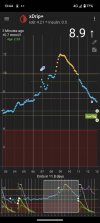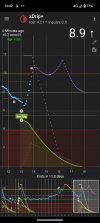SherwoodT1
Well-Known Member
- Messages
- 45
- Type of diabetes
- Type 1
- Treatment type
- Insulin
Hi all! Figure I'd pick the brain of the hive mind a little. I'm a little confused, to say the least.
I've noticed every morning my blood glucose will rise from 3am onwards. I'm aware this is the dawn phenomenon. But it seems to really hit hard as soon as my feet touch the floor from waking.
Today I thought I would try impromptu basal testing (of sorts). The graph is from this morning, after a dash of milk in a coffee and a couple boiled eggs. No carbs other than the drop of milk. (I'd have gone the whole hog and cut out everything but I'm working, and on my feet a lot, and the coffee was instinctual). No insulin beyond my basal too.
Now, I'm a year into diagnosis. So very aware I'm still honeymooning, albeit far less so than when first diagnosed.
I'm a touch baffled at the rise I saw this morning, despite limited carbs, followed by I assume my body naturally kicking in and regulating my blood glucose on its own. It leaves me scratching my head as how to tackle this on MDI.
Do people have any tips for this? My impromptu test was born out of struggling to dose for breakfast and going high despite my best efforts. It feels very much like insulin is water. How do people dial in a correction dose to preemptively tackle rises like this?
Thanks hive mind!
I've noticed every morning my blood glucose will rise from 3am onwards. I'm aware this is the dawn phenomenon. But it seems to really hit hard as soon as my feet touch the floor from waking.
Today I thought I would try impromptu basal testing (of sorts). The graph is from this morning, after a dash of milk in a coffee and a couple boiled eggs. No carbs other than the drop of milk. (I'd have gone the whole hog and cut out everything but I'm working, and on my feet a lot, and the coffee was instinctual). No insulin beyond my basal too.
Now, I'm a year into diagnosis. So very aware I'm still honeymooning, albeit far less so than when first diagnosed.
I'm a touch baffled at the rise I saw this morning, despite limited carbs, followed by I assume my body naturally kicking in and regulating my blood glucose on its own. It leaves me scratching my head as how to tackle this on MDI.
Do people have any tips for this? My impromptu test was born out of struggling to dose for breakfast and going high despite my best efforts. It feels very much like insulin is water. How do people dial in a correction dose to preemptively tackle rises like this?
Thanks hive mind!


